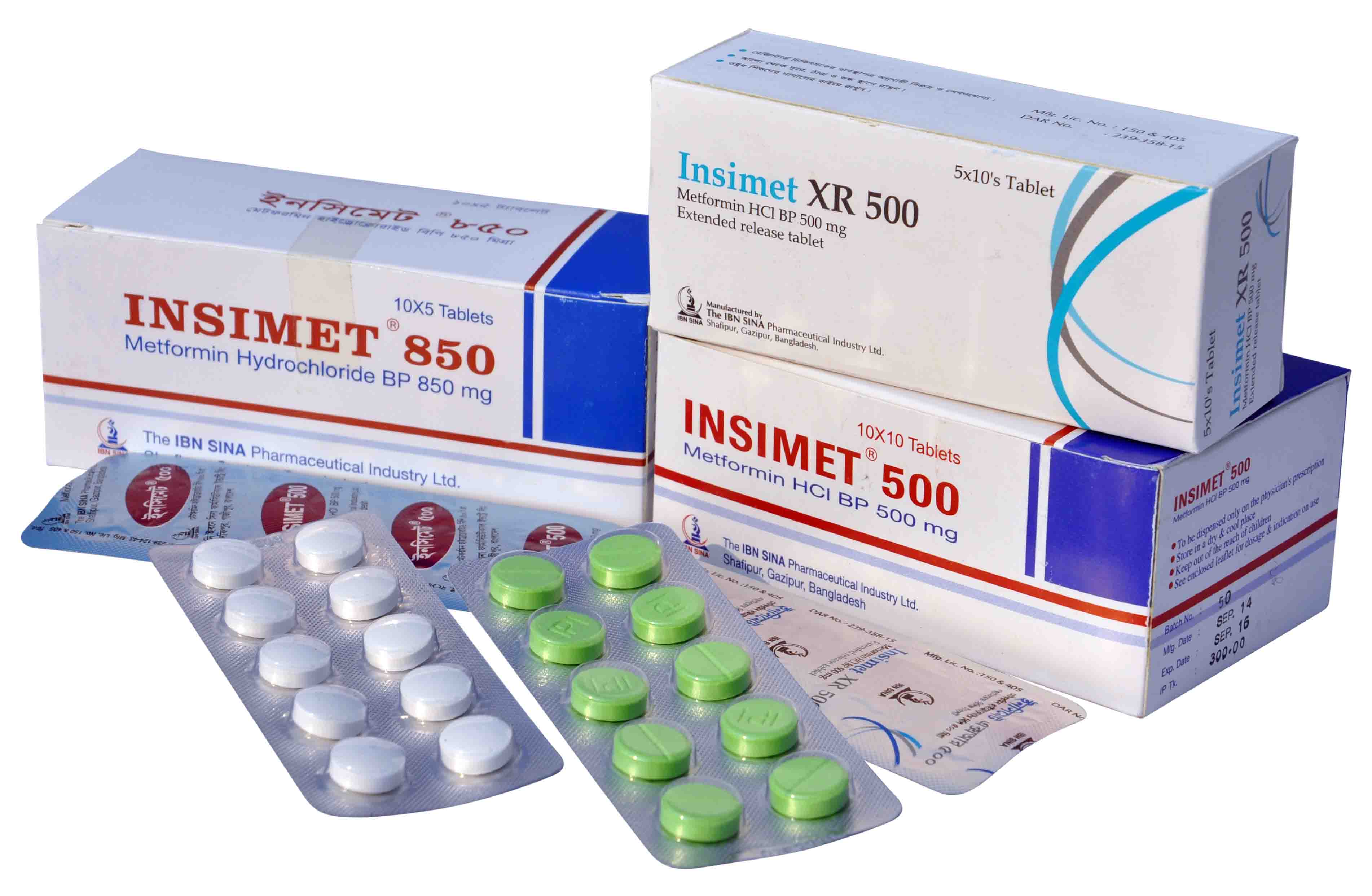
INSIMET
METFORMIN HCL BP
| NAME | STRENGTH | PACK SIZE | DOSAGE FORM |
|---|---|---|---|
| INSIMET 500 MG | 500 MG | 100 S | TABLET |
| INSIMET 850 MG | 850 MG | 50 S | TABLET |
Insimet 500 Tablet: Each film coated tablet contains Metformin Hydrochloride BP 500 mg. Insimet 850 Tablet : Each film coated tablet contains Metformin Hydrochloride BP 850 mg. Insimet XR 500 Tablet: Each extended release tablet contains Metformin Hydrochloride BP 500 mg.
Insimet (Metformin) is a biguanide type oral antihyperglycemic drug used in the management of type 2 diabetes. It lowers both basal and postprandial plasma glucose. Its mechanism of action is different from those of sulfonylureas and it does not produce hypoglycemia. Insimet decreases hepatic glucose production, decreases intestinal absorption of glucose and improves insulin sensitivity by an increase in peripheral glucose uptake and utilization.
Insimet, as monotherapy, is indicated as an adjunct to diet and exercise to improve glycemic control in patients with type 2 diabetes. Insimet is also indicated for use in combination therapy with an oral hypoglycemic agent or insulin when diet and exercise plus the single agent do not result in adequate glycemic control.
Dosage of Insimet or Insimet XR must be individualized on the basis of both effectiveness and tolerance, while not exceeding the maximum recommended daily dose. The maximum recommended daily dose of Insimet is 2550 mg in adults and 2000 mg in pediatric patients (10-16 years of age); the maximum recommended daily dose of Insimet XR in adults is 2000 mg. Insimet should be given in divided doses with meals while Insimet XR should generally be given once daily with the evening meal. Insimet XR tablet must be swallowed whole and never be crushed or chewed. Insimet or Insimet XR should be started at a low dose, with gradual dose escalation, both to reduce gastrointestinal side effects and to permit identification of the minimum dose required for adequate glycemic control of the patient. Recommended Dosing Schedule: a) Adults: The usual starting dose of Insimet is 500 mg twice a day or 850 mg once a day, given with meals. Dosage increases should be made in increments of 500 mg weekly or 850 mg every 2 weeks, up to a total of 2000 mg per day, given in divided doses. Patients can also be treated from 500 mg twice a day to 850 mg twice a day after 2 weeks. Doses above 2000 mg may be better tolerated given three times a day with meals. The usual starting dose of Insimet XR is 500 mg once daily with the evening meal. Dosage increases should be made in increments of 500 mg weekly, up to a maximum of 2000 mg once daily with the evening meal. If glycemic control is not achieved on Insimet XR 2000 mg once daily, a trial of Insimet XR 1000 mg twice daily should be considered. Patients receiving Insimet treatment may be safely switched to Insimet XR once daily at the same total daily dose, up to 2000 mg once daily. b) Pediatrics: The usual starting dose of Insimet is 500 mg twice a day, given with meals. Dosage increases should be made in increments of 500 mg weekly up to a maximum of 2000 mg per day, given in divided doses. Safety and effectiveness of Insimet in pediatric patients below 10 years have not been established.
Metformin hydrochloride is contraindicated in hepatic or renal impairment (withdraw if renal impairment is suspected), predisposition to lactic acidosis, heart failure, severe infection or trauma, dehydration, alcohol dependence, pregnancy, breast-feeding.
Metformin is known to be substantially excreted by the kidney and the risk of Metformin accumulation and lactic acidosis increases with the degree of impairment of renal function. Thus, patients with serum creatinine levels above the upper limit of normal for their age should not receive Metformin. In patients with advanced age, Metformin should be carefully titrated to establish the minimum dose for adequate glycemic effect, because aging is associated with reduced renal function.
Diarrhea (usually transient), nausea, vomiting, lactic acidosis (withdraw treatment), decreased vitamin B12 absorption.
Pregnancy: Pregnancy Category B. Most experts recommend that insulin should be used during pregnancy to maintain blood glucose levels as close to normal as possible. Both Metformin immediate and extended release tablets should not be used during pregnancy unless clearly needed. Because the potential for hypoglycemia in nursing infants may exist, a decision should be made whether to discontinue nursing or to discontinue the drug, taking into account the importance of the drug to the mother.
No information is available about the interaction of Metformin and furosemide when co-administered chronically. Nifedipine appears to enhance the absorption of Metformin. Metformin had minimal effects on nifedipine. Cationic drugs (e.g., amiloride, digoxin, morphine, procainamide, quinidine, quinine, ranitidine, triamterene, trimethoprim, or vancomycin) that are eliminated by renal tubular secretion theoretically have the potential for interaction with Metformin by competing for common renal tubular transport systems. Metformin had no effect on cimetidine pharmacokinetics. Certain drugs tend to produce hyperglycemia and may lead to loss of glycemic control. These drugs include the thiazides and other diuretics, corticosteroids, phenothiazines, thyroid products, estrogens, oral contraceptives, phenytoin, nicotinic acid, sympathomimetics, calcium channel blocking drugs, and isoniazid.
Overdose may cause symptoms of hypoglycemia, which may require the taking of sugar. Lactic acidosis symptoms may also occur.
Stored between 15°C to 30°C. Keep away from light and moisture. Keep out of reach of children.
Insimet 500 Tablet: Each box contains 10x10's tablet in blister pack. Insimet 850 Tablet: Each box contains 5x10's tablet in blister pack. Insimet XR 500 Tablet: Each box contains 5x10's tablet in blister pack.
